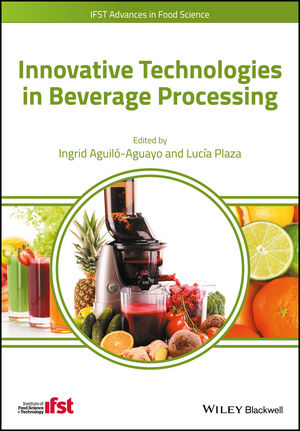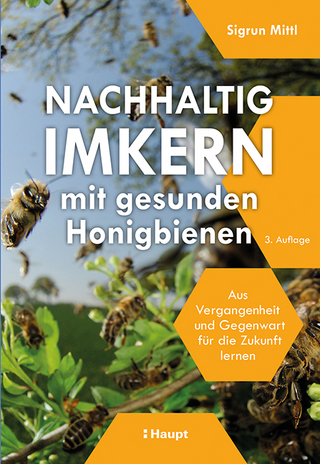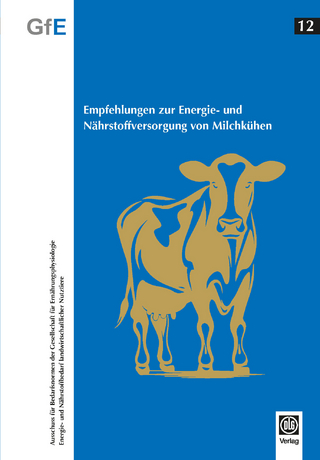
Innovative Technologies in Beverage Processing
John Wiley & Sons Inc (Verlag)
978-1-118-92937-7 (ISBN)
An in-depth look at new and emerging technologies for non-alcoholic beverage manufacturing
The non-alcoholic beverage market is the fastest growing segment of the functional food industry worldwide. Consistent with beverage consumption trends generally, the demand among consumers of these products is for high-nutrient drinks made from natural, healthy ingredients, free of synthetic preservatives and artificial flavor and color enhancers. Such drinks require specialized knowledge of exotic ingredients, novel processing techniques, and various functional ingredients.
The latest addition to the critically acclaimed IFST Advances in Food Science series this book brings together edited contributions from internationally recognized experts in their fields who offer insights and analysis of the latest developments in non-alcoholic beverage manufacture. Topics covered include juices made from pome fruits, citrus fruits, prunus fruits, vegetables, exotic fruits, berries, juice blends and non-alcoholic beverages, including grain-based beverages, soups and functional beverages. Waste and by-products generated in juice and non-alcoholic beverage sector are also addressed.
Offers fresh insight and analysis of the latest developments in non-alcoholic beverage manufacture from leading international experts
Covers all product segments of the non-alcoholic beverage market, including juices, vegetable blends, grain-based drinks, and alternative beverages
Details novel thermal and non-thermal technologies that ensure high-quality nutrient retention while extending product shelf life
Written with the full support of The Institute of Food Science and Technology (IFST), the leading qualifying body for food professionals in Europe
Innovative Technologies in Beverage Processing is a valuable reference/working resource for food scientists and engineers working in the non-alcoholic beverage industry, as well as academic researchers in industrial food processing and nutrition.
About the Editors Ingrid Aguiló-Aguayo, IRTA, XaRTA-Postharvest, Edifici Fruitcentre, Parc Científic i Tecnològic Agroalimentari de Lleida, Lleida, Spain Lucía Plaza, Research & Development Department, Cincagroup, Huesca, Spain
About the IFST Advances in Food Science Book Series xi
List of Contributors xiii
Preface xvi
List of Abbreviations xvii
Part 1: Juice Processing 1
1 Pome Fruit Juices 3
Ingrid Aguiló-Aguayo, Lucía Plaza, Gloria Bobo, Maribel Abadias, and Inmaculada Viñas
1.1 Introduction 3
1.2 Conventional Processing Techniques 3
1.2.1 Influence on Microbial Quality 4
1.2.2 Influence on Nutritional Attributes 5
1.2.3 Influence on Organoleptic Attributes 7
1.3 Novel Processing Techniques 8
1.3.1 Improvement in Juice Extraction 8
1.3.2 Improvement in Juice Clarification 9
1.3.3 Preservation of Pome Fruit Juices by Innovative Technologies 10
1.4 Conclusion and Future Trends 16
Acknowledgments 17
References 17
2 Citrus Fruit Juices 27
Maria Consuelo Pina-Pérez, Alejandro Rivas, Antonio Martínez, and Dolores Rodrigo
2.1 Introduction 27
2.2 Conventional Preservation Processing Techniques 28
2.2.1 Effect on Microbial Quality 28
2.2.2 Effect on Quality-Related Enzymes 29
2.2.3 Effect on Nutritional Quality 29
2.2.4 Effect on Organoleptic Quality 30
2.3 Novel Processing Techniques 30
2.3.1 Changes in Conventional Methods 30
2.3.2 Ohmic Heating 31
2.3.3 Microwave Heating 33
2.4 Processing Citrus by Innovative Methods 36
2.4.1 High-Pressure Processing 36
2.4.2 Pulsed Electric Fields 40
2.5 Conclusions and Future Trends 47
References 47
3 Prunus Fruit Juices 59
Gamze Toydemir, Dilek Boyacioglu, Robert D. Hall, Jules Beekwilder, and Esra Capanoglu
3.1 Introduction 59
3.2 Conventional Processing Techniques 60
3.2.1 Cherry and Sour Cherry 60
3.2.2 Apricot, Peach, and Nectarine 62
3.2.3 Plum 63
3.3 Influence of Conventional Processing Techniques on Juice Quality 64
3.4 Novel Processing Techniques 65
3.4.1 Pulsed Electric Fields 65
3.4.2 High-Pressure Processing 67
3.4.3 Other Innovative Technologies 70
3.5 Conclusion and Future Trends 71
References 72
4 Vegetable Juices 79
Rogelio Sánchez-Vega, David Sepúlveda-Ahumada, and Ma. Janeth Rodríguez-Roque
4.1 Introduction 79
4.2 Conventional Processing Technologies 81
4.2.1 Influence of Conventional Processing on Microbial Quality 81
4.2.2 Influence of Conventional Processing on Nutritional Attributes 81
4.2.3 Influence of Conventional Processing on Organoleptic Attributes 85
4.3 Nonthermal Processing Technologies 96
4.3.1 Influence of Nonthermal Processing on Microbial Quality 96
4.3.2 Influence of Nonthermal Processing on Nutritional Attributes 97
4.3.3 Influence of Nonthermal Processing on Organoleptic Attributes 99
4.4 Conclusion and Future Trends 100
References 100
5 Exotic Fruit Juices 107
Zamantha Escobedo-Avellaneda, Rebeca García-García, and Jorge Welti-Chanes
5.1 Introduction 107
5.2 Exotic Fruits: Relevance in Human Nutrition and Health 109
5.3 Deterioration of Exotic Fruit Juices 111
5.4 Thermal and Nonthermal Technologies Used to Preserve Juices 112
5.4.1 Thermal Processing 113
5.4.2 Nonthermal Processing 116
5.5 Conclusions and Future Trends 122
References 122
6 Berry Juices 131
Sze Ying Leong and Indrawati Oey
6.1 Introduction 131
6.2 Conventional Processing Techniques 131
6.2.1 Influence on Microbial Quality 132
6.2.2 Influence on Nutritional Attributes 133
6.2.3 Influence on Organoleptic Attributes 160
6.3 Novel Processing Techniques 163
6.3.1 Changes in Conventional Methods 164
6.3.2 Processing Berry Juice by Innovative Technologies 164
6.3.3 Preservation of Berry Juice by Innovative Technologies 166
6.4 Relevance for Human Health 188
6.5 Conclusions and Future Trends 190
References 190
7 Juice Blends 205
Francisco J. Barba, Elena Roselló-Soto, Francisco Quilez, and Nabil Grimi
7.1 Introduction 205
7.2 Pulsed Electric Fields 206
7.2.1 Food Safety 207
7.2.2 Nutritionally Valuable Compounds 208
7.3 High-Pressure Processing 210
7.3.1 Food Safety 211
7.3.2 Nutritionally Valuable Compounds 211
7.4 Conclusion 213
Acknowledgments 213
References 213
Part 2: Non-alcoholic Beverages 217
8 Grain-Based Beverages 219
Aastha Deswal, Navneet S. Deora, and Hari N. Mishra
8.1 Introduction 219
8.1.1 Soy-Based Beverages 220
8.1.2 Rice-Based Beverages 220
8.1.3 Oat-Based Beverages 221
8.2 Conventional Processing Techniques 222
8.2.1 Heating Methods 222
8.2.2 Fermentation 223
8.2.3 Influence on Microbial Quality 224
8.2.4 Influence on Nutritional Attributes 225
8.2.5 Influence on Organoleptic Attributes 227
8.3 Novel Processing Techniques 227
8.3.1 High and Ultra-High-Pressure Homogenisation 227
8.3.2 High-Pressure Processing 228
8.3.3 Pulsed Electric Field 230
8.3.4 Enzymatic Techniques 231
8.3.5 Changes in Conventional Methods 232
8.4 Processing Grain-Based Beverages by Innovative Techniques 233
8.4.1 Enzymatic Techniques 233
8.4.2 Fermentation 234
8.4.3 Ultra-High-Pressure Homogenisation 235
8.5 Preservation of Grain-Based Beverages by Innovative Technologies 235
8.5.1 High-Pressure Processing 235
8.5.2 Pulsed Electric Field 237
8.6 Relevance for Human Nutrition 237
8.7 Conclusion and Future Trends 238
References 238
9 Soups 249
Begoña de Ancos and Concepción Sánchez-Moreno
9.1 Introduction 249
9.1.1 Processed Foods 249
9.1.2 Ready-to-Eat Meals: Soups 250
9.2 Non-Thermal Technologies for Food Processing 252
9.2.1 High-Pressure Processing 252
9.2.2 Pulsed Electric Fields 256
9.3 Novel Thermal Technologies for Food Processing 259
9.3.1 Ohmic Heating 259
9.3.2 Microwave and Radiofrequency Heating 262
Acknowledgments 265
References 265
10 Functional Beverages 275
Francesc Puiggròs, Begoña Muguerza, Anna Arola-Arnal, Gerard Aragonès, Susana Suárez-Garcia, Cinta Bladé, Lluís Arola, and Manuel Suárez
10.1 Introduction 275
10.2 Functional Food Regulation 276
10.3 Natural Ingredients in the Formulation of Functional Beverages 277
10.4 New Trends in the Formulation of Functional Beverages 279
10.4.1 Tendencies in Fruit Ingredients 279
10.4.2 Green Botanicals in Beverages 279
10.4.3 By-Products in Beverage Formulation 280
10.5 Novel Infusions (Tea and Tea Alternatives) 281
10.6 Fortified Beverages 283
10.7 Cocoa-Based Beverages 285
10.8 Energy Drinks 286
10.9 Beverage Emulsions 287
10.10 Conclusions and Future Trends 288
References 288
Part 3: Waste in the Juice and Non-alcoholic Beverage Sector 297
11 Waste/By-Product Utilisations 299
Ciaran Fitzgerald, Mohammad Hossain, and Dilip K. Rai
11.1 Introduction 299
11.2 Major Waste and By-Products Generated from the Juice and Non-Alcoholic Beverage Sector 299
11.3 Utilisation of By-Products from the Non-Alcoholic Beverage Sector 301
11.3.1 Animal Feed 301
11.3.2 Pectin 303
11.3.3 Biofuel 303
11.3.4 Flavour and Aroma 304
11.3.5 Food Additives 304
11.4 Potential Sources of Bioactive Compounds 305
11.4.1 Phenolic Compounds 305
11.4.2 Bioactive Peptides 305
11.5 Novel Technologies Involved in the Processing of Fruit Beverage Waste 305
11.5.1 Pulsed Electric Field 305
11.5.2 Ultrasonication 306
References 306
Index 311
| Erscheinungsdatum | 10.08.2017 |
|---|---|
| Reihe/Serie | IFST Advances in Food Science |
| Verlagsort | New York |
| Sprache | englisch |
| Maße | 173 x 244 mm |
| Gewicht | 703 g |
| Themenwelt | Technik |
| Weitere Fachgebiete ► Land- / Forstwirtschaft / Fischerei | |
| ISBN-10 | 1-118-92937-3 / 1118929373 |
| ISBN-13 | 978-1-118-92937-7 / 9781118929377 |
| Zustand | Neuware |
| Haben Sie eine Frage zum Produkt? |
aus dem Bereich


